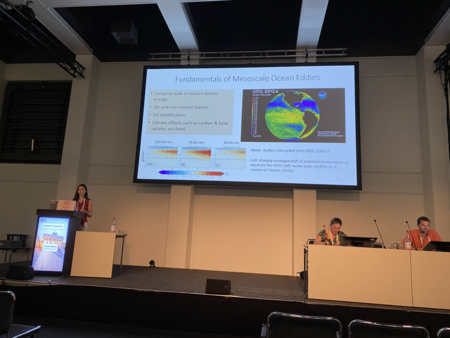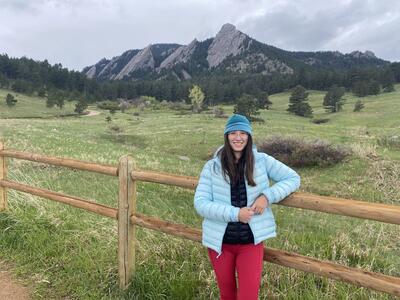
By Michaela Herrmann
Every year, Yale’s Faculty of Arts and Sciences hires dozens of exceptional scholars in academic departments across the sciences, humanities, and social sciences. This series profiles six of the faculty joining the FAS in the 2024—25 academic year, highlighting their academic achievements, research ambitions, and the teaching they hope to do at Yale. Learn more about the incoming ladder faculty and multi-year instructional faculty joining the FAS.
Science is a fundamentally iterative, collaborative process: hypotheses are posited, theories developed, and both tested rigorously over many generations. It’s tough to imagine an academic discipline with more scientists working together in real-time than the field of climate modelling, of which new FAS faculty Elizabeth Yankovsky is a part.
Yankovsky joins the Department of Earth and Planetary Sciences as Assistant Professor. At Yale, she’ll blend physics, computer science, and approaches from other fields to continue her research on ocean turbulence and improving global climate models—projects that require her to remotely log into supercomputing systems developed and refined by scientists in modeling centers around the globe.
Her specialty is ocean turbulence, or how energy is added to the ocean through large-scale forcings like sun and wind, then removed by small-scale interactions between water molecules.
“Turbulence really refers to the multi-scale interactions between all of these different scales,” she explains. “So energy is put into the ocean, leading to the formation of large eddies, whirlpools, global scale currents. Eventually, there are different types of instabilities, waves, and other interesting fluid processes that transfer that energy to smaller scales where it’s dissipated and removed.”
Yankovsky’s research on turbulence can in turn be used to improve the accuracy of climate modeling, which relies on numerical simulations to predict how Earth’s climate may change based on different inputs to the climate system—more atmospheric heat, or greater ocean alkalinity, for example. “Turbulence in the ocean is nonlinear and chaotic, which makes it really hard to study and predict how the ocean and the climate are going to evolve with time,” Yankovsky explains. That chaos means a robust understanding of turbulence is crucial for modeling the overarching climate system as accurately as possible.
She would have joined the faculty a year earlier if not for an incredible opportunity to broaden her scientific horizons in Boulder, Colorado before moving to Yale. “Everyone here was very flexible about letting me defer my start date by a year, so I spent the last year at an organization that is working on carbon dioxide removal through various geoengineering projects in the ocean,” Yankovsky says.
 That year allowed her to broaden her understanding of the ocean’s chemistry and biology alongside her established knowledge of its physics. “I was really surprised how important ocean turbulence is in the process [of increasing ocean alkalinity],” she says, describing how geoengineering can mimic Earth’s natural weathering process. As rain erodes alkaline minerals and washes them into the world’s oceans, the ocean itself becomes more alkaline, thus increasing its ability to absorb CO2. This weathering process speeds up when the Earth’s atmosphere is warmer and slows down when it’s cooler, making it a great example of one of the Earth’s natural feedback loops that are affected by climate change.
That year allowed her to broaden her understanding of the ocean’s chemistry and biology alongside her established knowledge of its physics. “I was really surprised how important ocean turbulence is in the process [of increasing ocean alkalinity],” she says, describing how geoengineering can mimic Earth’s natural weathering process. As rain erodes alkaline minerals and washes them into the world’s oceans, the ocean itself becomes more alkaline, thus increasing its ability to absorb CO2. This weathering process speeds up when the Earth’s atmosphere is warmer and slows down when it’s cooler, making it a great example of one of the Earth’s natural feedback loops that are affected by climate change.
Geoengineers are trying to take advantage of the weathering process to absorb some of the excess atmospheric CO2 that’s driving global climate change. “[With ocean carbon dioxide removal], essentially what you’re doing is putting an alkalinity source at the surface. One of the biggest questions is how that disperses both vertically and horizontally, because if that alkalinity sinks below the surface of the ocean, it’s no longer causing any CO2 uptake,” she explains. “I came into that project not really thinking that my past research experiences were that relevant, but understanding the vertical structure of mixing and turbulence ended up being one of the most important applications of my past research.”
For a scientist who spends a lot of her time essentially conducting experiments in the virtual lab of climate modeling software, “it has been very inspiring to see all of these physical oceanographers and climate scientists getting involved in this field,” she says. “It’s a great application of the specific problems that we work on in the ocean modeling community, and it’s suddenly very relevant to society.”
That year of research in Boulder has already led Yankovsky to new connections on campus. “I’ve become a member of the Yale Center for Natural Carbon Capture, and talking to some of the other scientists in that space has been really interesting. Looking beyond the ocean alkalinity enhancement work that I’ve done already, I’m excited to collaborate more with people at the YCNCC and with other faculty.”

The chance to work with scientists across Earth sciences and beyond was a large part of what drew Yankovsky to Yale. “I came into Earth sciences from geophysics originally, but sometimes it almost feels arbitrary to me which specific problem I’m working on. There are so many interesting questions in the broad field of Earth sciences, and I’m just really excited to be around geophysicists and paleontologists and people that study different components of the Earth system that are ultimately intimately linked.”
“I’ve also been really pleased by how kind everyone is in this department,” she adds, excited at the prospect for thriving collaborations within Earth and Planetary Sciences. “I don’t think that’s necessarily a common feature, and through my interview process, negotiation process, and finally coming here, everyone has been super supportive and helpful.”
As she looks forward to getting back into the cadence of the academic calendar, Yankovsky is planning to teach classes that introduce students to climate modeling, how numerical models can be used to understand fluid dynamics and geophysical systems, and some of the techniques and complexities of the field.
Yankovsky hopes to mentor students and help guide them through a crucial yet occasionally confusing part of their academic careers. “When I was an undergraduate, I remember feeling a bit overwhelmed and lost with the amount of research options. It’s such a critical stage in your career development. Particularly for students that decide to pursue graduate studies, they have just a few short years to decide what sort of research and field inspires them,” she reflects. “I’m so grateful to the people who took the time to sit, code, work deeply with, and teach me during those years, and I’m excited to fulfill that role for my future students.”
As Yankovsky anticipates a new chapter in New Haven, she reflects on one last thing Boulder gave her: a new love of its namesake activity. “I recently started bouldering, which I’ve never really done before,” she says. She’s eager to get to know the nature surrounding New Haven and volunteer at some local animal shelters. “I really love climbing, and I’m looking forward to getting to know the climbing areas around here and the climbing gyms,” she says, ready to reach new heights in her field, the classroom, and beyond.
Image 2: Yankovsky presenting her research at an academic conferece.
Image 3: Yankovsky standing in front of mountains in Chautauqua Park in Boulder, Colorado.